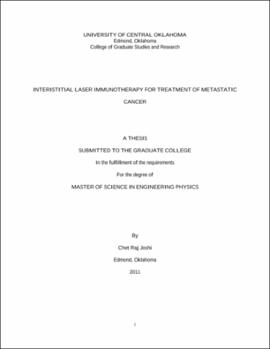| dc.contributor.advisor | Chen, Wei | |
| dc.contributor.author | Joshi, Chet Raj | |
| dc.date.accessioned | 2020-05-26T20:37:29Z | |
| dc.date.available | 2020-05-26T20:37:29Z | |
| dc.date.issued | 2011 | |
| dc.identifier.other | (AlmaMMSId)9978509685202196 | |
| dc.identifier.uri | https://hdl.handle.net/11244/324658 | |
| dc.description.abstract | Cancer is one of the leading causes of death in the world. Although widely used, currently available cancer treatment modalities such as surgery, chemotherapy and radiation have limited effects in curing the disease and prolonging the life oflate-stage cancer patients. A novel therapy, laser immunotherapy (LIT) has been developed for the treatment of late-stage metastatic cancers. LIT uses laser light to kill cancer cells and a non-toxic immunoadjuvant, glycated chitosan (GC) to stimulate the host immune system. It fights against residual tumor cells, as well as metastases at distant sites. LIT is a combination of photothermal therapy and immunotherapy. The current application of LIT is non-invasive, using light to penetrate surface skin tissue to treat underlying tumor cells. Modifications to the LIT treatment are necessary to effectively treat patients with pigmented skin and deep tumors. Thus, interstitial laser immunotherapy (ILIT), using an invasive laser irradiation approach, is proposed. The present study is designed to investigate the effectiveness of ILIT using an 805-nm laser. DMBA-4 metastatic mammary tumor cells line in Wistar Furth female rats was used. Irradiation of rat tumors was performed using an interstitial fiber with a cylindrical diffuser. The temperature distribution inside the target tumor tissue, an important factor affecting the outcome of ILIT, was monitored with a thermocouple by inserting needle probes into the tissue around the cylindrical diffuser duringlaser irradiation. To measure the three-dimensional temperature distribution in the target tissue, the proton resonance frequency (PRF) method was conducted using a 7.1-Tesla magnetic resonance imager. Our results showed that the temperature distribution in tissue depended on laser power and irradiation duration. The temperature inside the target tumor varied with the distance from the laser diffuser tip. Thermal damage to the tumor was examined using triphenyltetrazoium chloride (TTC) staining as well as hematoxolin and erosion (H&E) staining. Animal survival as well as tumor size over time was monitored. Our results indicate that ILIT had a much greater thermal impact on target tumors with less surface damage than LIT. The survival study also indicates that ILIT has better potential for treating metastases and deep tumors, while having fewer side effects than LIT. | |
| dc.rights | All rights reserved by the author, who has granted UCO Chambers Library the non-exclusive right to share this material in its online repositories. Contact UCO Chambers Library's Digital Initiatives Working Group at diwg@uco.edu for the permission policy on the use, reproduction or distribution of this material. | |
| dc.subject.lcsh | Cancer | |
| dc.subject.lcsh | Metastasis | |
| dc.title | Interistitial laser immunotherapy for treatment of metastatic cancer. | |
| dc.type | Academic theses | |
| dc.contributor.committeeMember | Lemley, Evan | |
| dc.contributor.committeeMember | Miller, Ronald | |
| dc.thesis.degree | M.S., Engineering Physics | |
| dc.identifier.oclc | (OCoLC)ocn839686302 | |
| uco.group | UCO - Graduate Works and Theses::UCO - Theses | |
| thesis.degree.grantor | Jackson College of Graduate Studies | |
